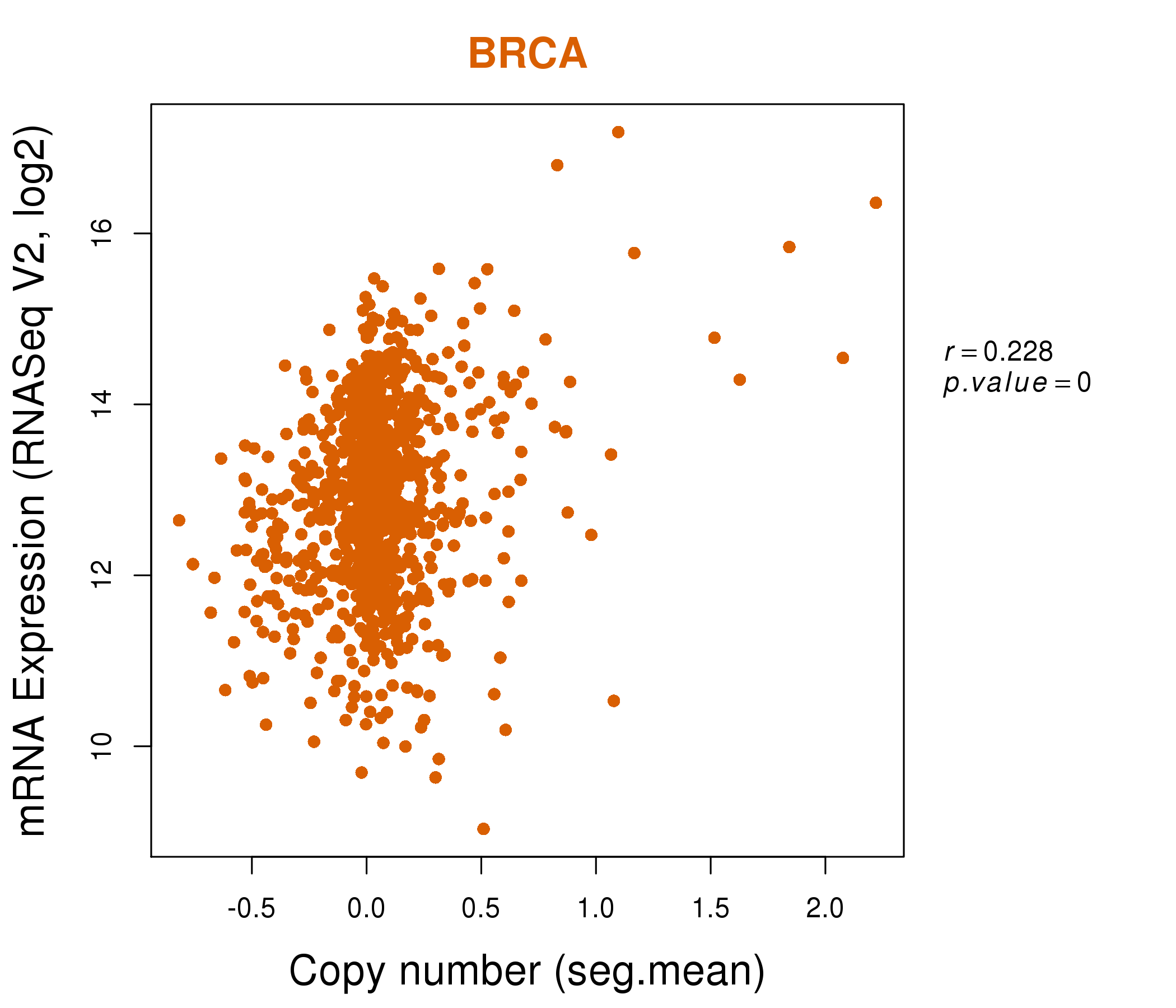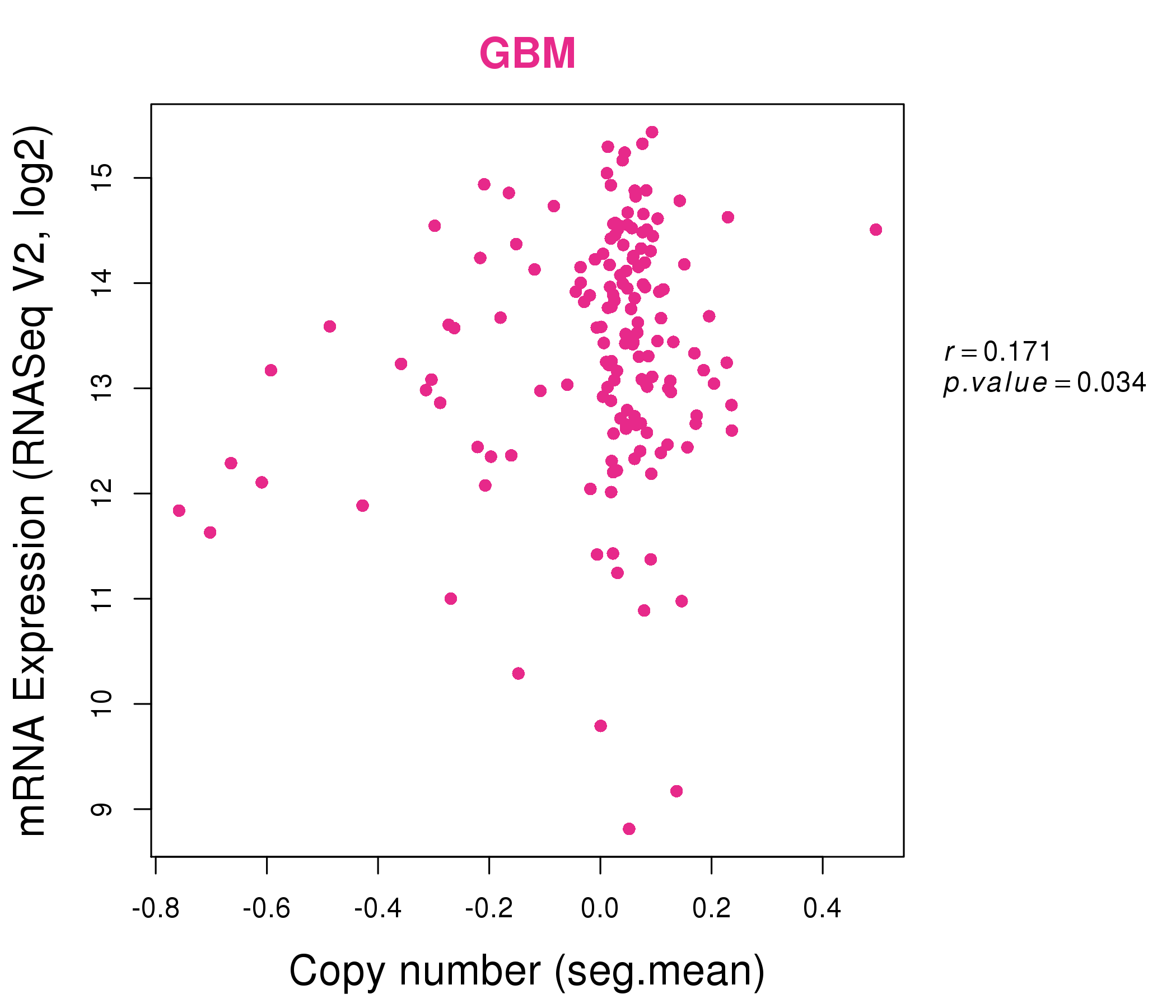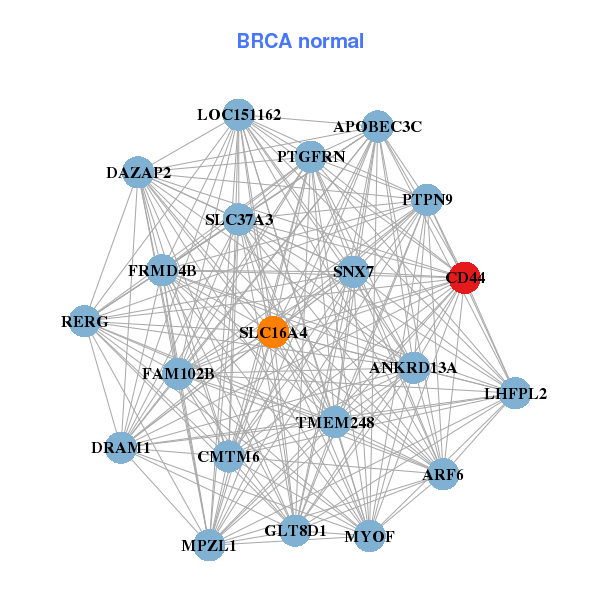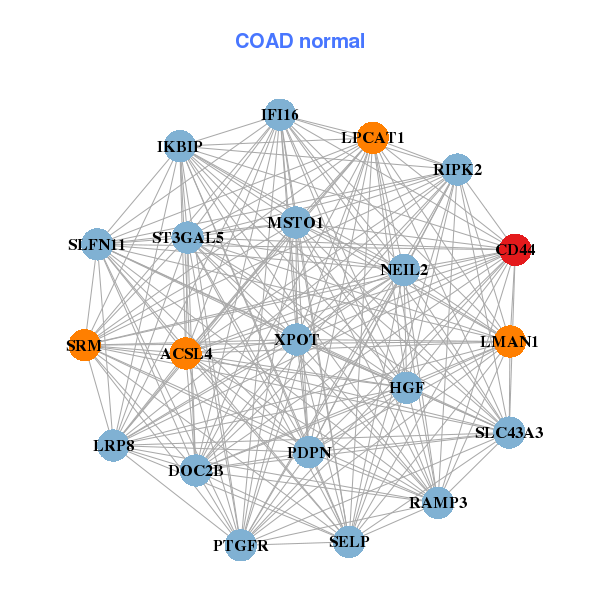|
||||||||||||||||||||||||||||||||||||||||||||||||||||||||||||||||||||||||||||||||||||||||||||||||||||||||||||||||||||||||||||||||||||||||||||||||||||||||||||||||||||||||||||||||||||||||||||||||||||||||||||||||||||||||||||||||||||||||||||||||||||||||||||||||||||||||||||||||||||||||||||||||||||||||||||||||||||||||||
| |
| Phenotypic Information (metabolism pathway, cancer, disease, phenome) |
| |
| |
| Gene-Gene Network Information: Co-Expression Network, Interacting Genes & KEGG |
| |
|
| Gene Summary for CD44 |
| Basic gene info. | Gene symbol | CD44 |
| Gene name | CD44 molecule (Indian blood group) | |
| Synonyms | CDW44|CSPG8|ECMR-III|HCELL|HUTCH-I|IN|LHR|MC56|MDU2|MDU3|MIC4|Pgp1 | |
| Cytomap | UCSC genome browser: 11p13 | |
| Genomic location | chr11 :35160416-35253949 | |
| Type of gene | protein-coding | |
| RefGenes | NM_000610.3, NM_001001389.1,NM_001001390.1,NM_001001391.1,NM_001001392.1, NM_001202555.1,NM_001202556.1,NM_001202557.1, | |
| Ensembl id | ENSG00000026508 | |
| Description | CD44 antigenGP90 lymphocyte homing/adhesion receptorHermes antigencell surface glycoprotein CD44chondroitin sulfate proteoglycan 8epicanextracellular matrix receptor IIIhematopoietic cell E- and L-selectin ligandheparan sulfate proteoglycanhoming | |
| Modification date | 20141222 | |
| dbXrefs | MIM : 107269 | |
| HGNC : HGNC | ||
| Ensembl : ENSG00000026508 | ||
| HPRD : 00115 | ||
| Vega : OTTHUMG00000044388 | ||
| Protein | UniProt: P16070 go to UniProt's Cross Reference DB Table | |
| Expression | CleanEX: HS_CD44 | |
| BioGPS: 960 | ||
| Gene Expression Atlas: ENSG00000026508 | ||
| The Human Protein Atlas: ENSG00000026508 | ||
| Pathway | NCI Pathway Interaction Database: CD44 | |
| KEGG: CD44 | ||
| REACTOME: CD44 | ||
| ConsensusPathDB | ||
| Pathway Commons: CD44 | ||
| Metabolism | MetaCyc: CD44 | |
| HUMANCyc: CD44 | ||
| Regulation | Ensembl's Regulation: ENSG00000026508 | |
| miRBase: chr11 :35,160,416-35,253,949 | ||
| TargetScan: NM_000610 | ||
| cisRED: ENSG00000026508 | ||
| Context | iHOP: CD44 | |
| cancer metabolism search in PubMed: CD44 | ||
| UCL Cancer Institute: CD44 | ||
| Assigned class in ccmGDB | A - This gene has a literature evidence and it belongs to cancer gene. | |
| References showing role of CD44 in cancer cell metabolism | 1. Misra S, Hascall VC, Markwald RR, Ghatak S (2015) Interactions between Hyaluronan and Its Receptors (CD44, RHAMM) Regulate the Activities of Inflammation and Cancer. Front Immunol 6: 201. doi: 10.3389/fimmu.2015.00201. pmid: 4422082 go to article 2. Takahashi H, Nishimura J, Kagawa Y, Kano Y, Takahashi Y, et al. (2015) Significance of Polypyrimidine Tract-Binding Protein 1 Expression in Colorectal Cancer. Mol Cancer Ther 14: 1705-1716. doi: 10.1158/1535-7163.MCT-14-0142. go to article | |
| Top |
| Phenotypic Information for CD44(metabolism pathway, cancer, disease, phenome) |
| Cancer | CGAP: CD44 |
| Familial Cancer Database: CD44 | |
| * This gene is included in those cancer gene databases. |
|
|
|
|
|
| . | ||||||||||||||||||||||||||||||||||||||||||||||||||||||||||||||||||||||||||||||||||||||||||||||||||||||||||||||||||||||||||||||||||||||||||||||||||||||||||||||||||||||||||||||||||||||||||||||||||||||||||||||||||||||||||||||||||||||||||||||||||||||||||||||||||||||||||||||||||||||||||||||||||||||||||||||||||||
Oncogene 1 | Significant driver gene in | |||||||||||||||||||||||||||||||||||||||||||||||||||||||||||||||||||||||||||||||||||||||||||||||||||||||||||||||||||||||||||||||||||||||||||||||||||||||||||||||||||||||||||||||||||||||||||||||||||||||||||||||||||||||||||||||||||||||||||||||||||||||||||||||||||||||||||||||||||||||||||||||||||||||||||||||||||||||||
| cf) number; DB name 1 Oncogene; http://nar.oxfordjournals.org/content/35/suppl_1/D721.long, 2 Tumor Suppressor gene; https://bioinfo.uth.edu/TSGene/, 3 Cancer Gene Census; http://www.nature.com/nrc/journal/v4/n3/abs/nrc1299.html, 4 CancerGenes; http://nar.oxfordjournals.org/content/35/suppl_1/D721.long, 5 Network of Cancer Gene; http://ncg.kcl.ac.uk/index.php, 1Therapeutic Vulnerabilities in Cancer; http://cbio.mskcc.org/cancergenomics/statius/ |
| REACTOME_HYALURONAN_METABOLISM REACTOME_METABOLISM_OF_CARBOHYDRATES | |
| OMIM | 107269; gene. 107269; gene. 172290; gene. 172290; gene. 609027; phenotype. 609027; phenotype. |
| Orphanet | |
| Disease | KEGG Disease: CD44 |
| MedGen: CD44 (Human Medical Genetics with Condition) | |
| ClinVar: CD44 | |
| Phenotype | MGI: CD44 (International Mouse Phenotyping Consortium) |
| PhenomicDB: CD44 | |
| Mutations for CD44 |
| * Under tables are showing count per each tissue to give us broad intuition about tissue specific mutation patterns.You can go to the detailed page for each mutation database's web site. |
| - Statistics for Tissue and Mutation type | Top |
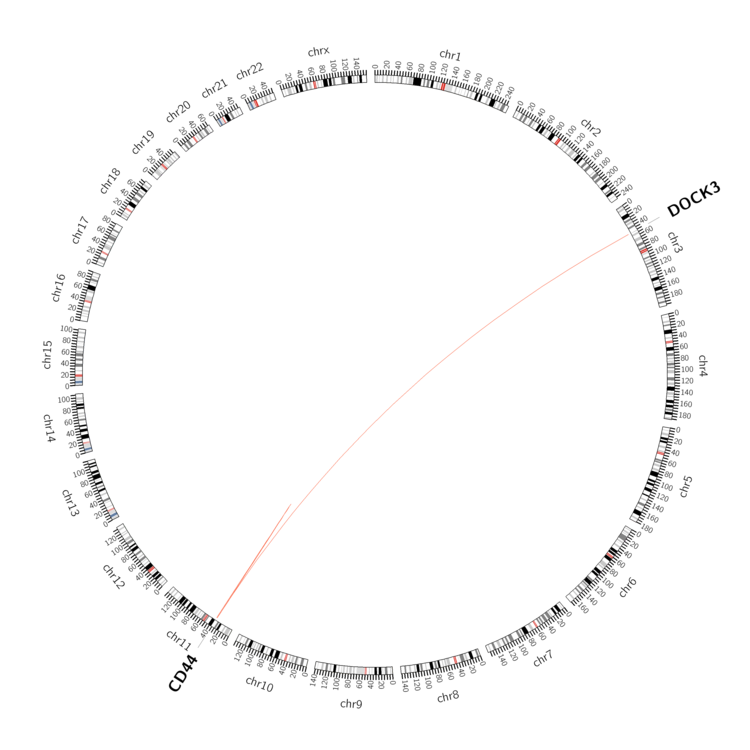 |
| - For Inter-chromosomal Variations |
| * Inter-chromosomal variantions includes 'interchromosomal amplicon to amplicon', 'interchromosomal amplicon to non-amplified dna', 'interchromosomal insertion', 'Interchromosomal unknown type'. |
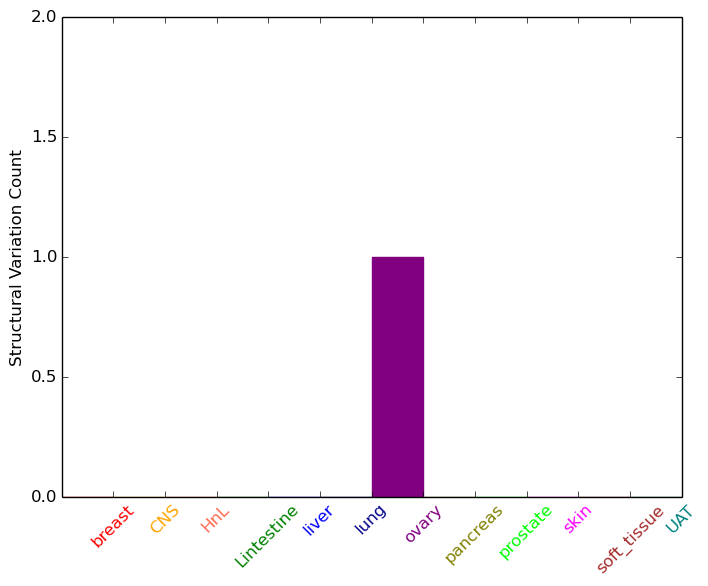 |
| - For Intra-chromosomal Variations |
| * Intra-chromosomal variantions includes 'intrachromosomal amplicon to amplicon', 'intrachromosomal amplicon to non-amplified dna', 'intrachromosomal deletion', 'intrachromosomal fold-back inversion', 'intrachromosomal inversion', 'intrachromosomal tandem duplication', 'Intrachromosomal unknown type', 'intrachromosomal with inverted orientation', 'intrachromosomal with non-inverted orientation'. |
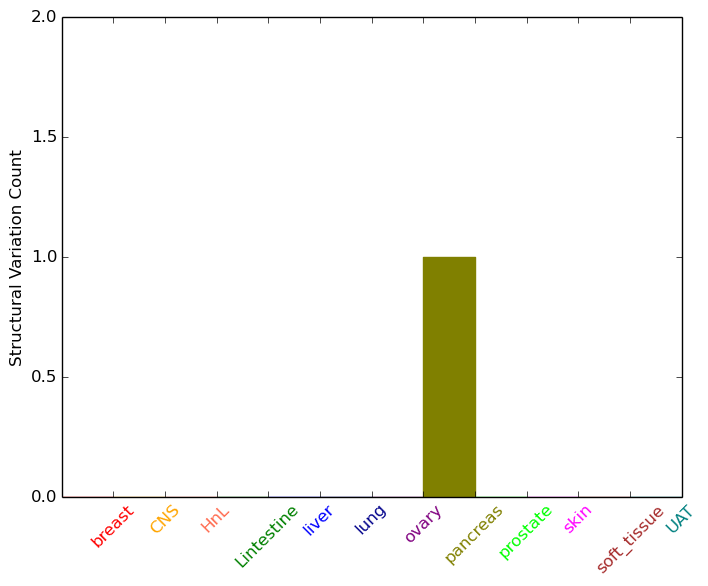 |
| Sample | Symbol_a | Chr_a | Start_a | End_a | Symbol_b | Chr_b | Start_b | End_b |
| pancreas | CD44 | chr11 | 35186096 | 35186116 | chr11 | 36267498 | 36267518 |
| cf) Tissue number; Tissue name (1;Breast, 2;Central_nervous_system, 3;Haematopoietic_and_lymphoid_tissue, 4;Large_intestine, 5;Liver, 6;Lung, 7;Ovary, 8;Pancreas, 9;Prostate, 10;Skin, 11;Soft_tissue, 12;Upper_aerodigestive_tract) |
| * From mRNA Sanger sequences, Chitars2.0 arranged chimeric transcripts. This table shows CD44 related fusion information. |
| ID | Head Gene | Tail Gene | Accession | Gene_a | qStart_a | qEnd_a | Chromosome_a | tStart_a | tEnd_a | Gene_a | qStart_a | qEnd_a | Chromosome_a | tStart_a | tEnd_a |
| DA471107 | CD44 | 1 | 204 | 11 | 35160718 | 35160921 | PDHX | 200 | 567 | 11 | 34952950 | 34979115 | |
| BP270776 | NAA10 | 1 | 325 | X | 153197866 | 153200438 | CD44 | 320 | 583 | 11 | 35251215 | 35251476 | |
| BE695450 | SON | 22 | 230 | 21 | 34929527 | 34929965 | CD44 | 217 | 320 | 11 | 35250784 | 35250887 | |
| BI038422 | CD44 | 5 | 151 | 11 | 35194829 | 35194974 | COX15 | 151 | 392 | 10 | 101486747 | 101487274 | |
| AW376462 | CD44 | 1 | 57 | 11 | 35252818 | 35252874 | CD44 | 52 | 487 | 11 | 35252927 | 35253360 | |
| BF748398 | CD44 | 1 | 177 | 11 | 35201902 | 35211434 | SLC4A2 | 168 | 376 | 7 | 150772771 | 150773216 | |
| AW580058 | CD44 | 1 | 148 | 11 | 35222883 | 35223031 | CD44 | 144 | 374 | 11 | 35223063 | 35223293 | |
| BM280254 | CD44 | 18 | 147 | 11 | 35250886 | 35251015 | CD44 | 143 | 303 | 11 | 35250675 | 35250835 | |
| AW935153 | TMEM50B | 12 | 369 | 21 | 34821524 | 34821880 | CD44 | 370 | 617 | 11 | 35233263 | 35233511 | |
| EY123442 | CD44 | 8 | 295 | 11 | 35250716 | 35251011 | SERINC5 | 289 | 310 | 5 | 79453346 | 79453367 | |
| Top |
| Mutation type/ Tissue ID | brca | cns | cerv | endome | haematopo | kidn | Lintest | liver | lung | ns | ovary | pancre | prost | skin | stoma | thyro | urina | |||
| Total # sample | 2 | 1 | 2 | 1 | 1 | 3 | ||||||||||||||
| GAIN (# sample) | 1 | 1 | 1 | 1 | 3 | |||||||||||||||
| LOSS (# sample) | 1 | 1 | 1 |
| cf) Tissue ID; Tissue type (1; Breast, 2; Central_nervous_system, 3; Cervix, 4; Endometrium, 5; Haematopoietic_and_lymphoid_tissue, 6; Kidney, 7; Large_intestine, 8; Liver, 9; Lung, 10; NS, 11; Ovary, 12; Pancreas, 13; Prostate, 14; Skin, 15; Stomach, 16; Thyroid, 17; Urinary_tract) |
| Top |
|
 |
| Top |
| Stat. for Non-Synonymous SNVs (# total SNVs=48) | (# total SNVs=13) |
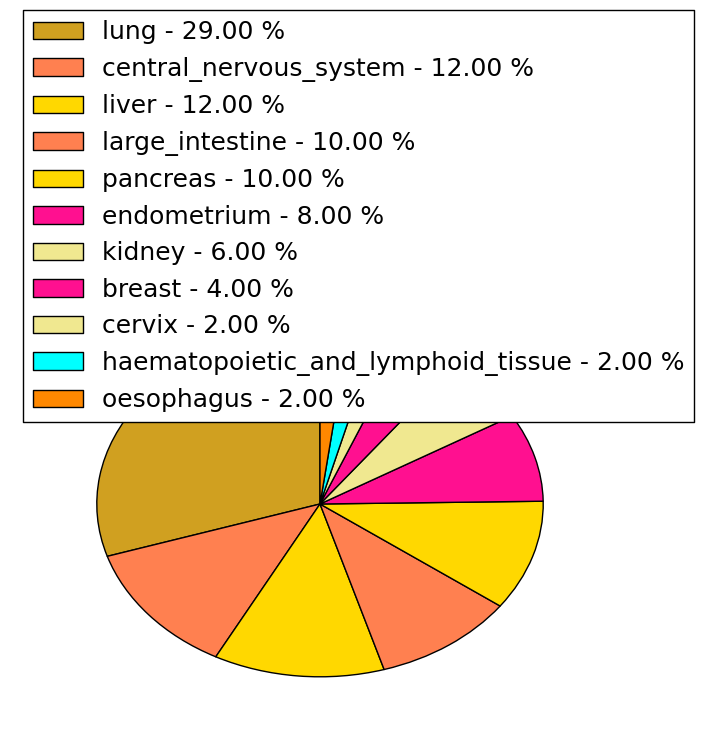 | 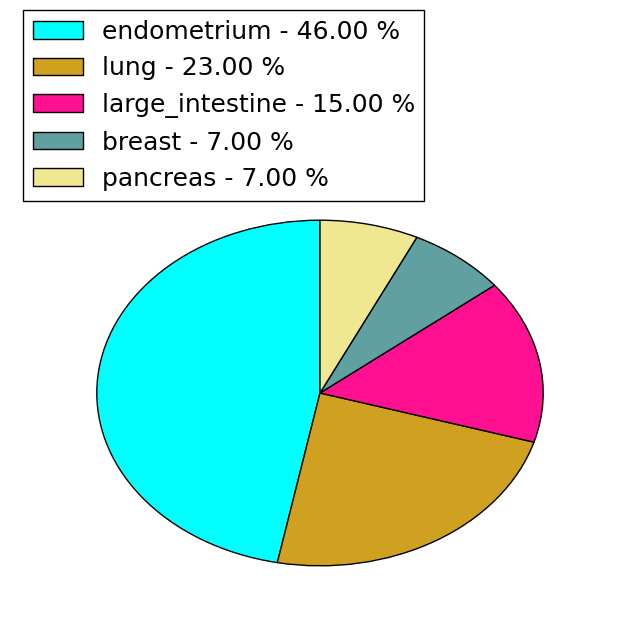 |
(# total SNVs=2) | (# total SNVs=0) |
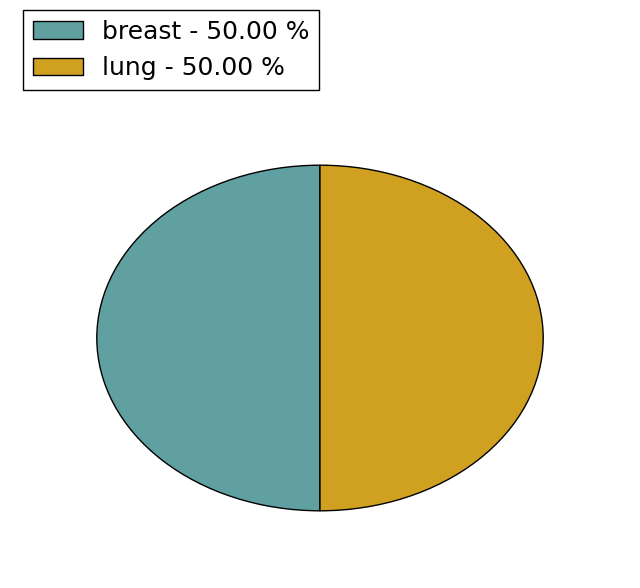 |
| Top |
| * When you move the cursor on each content, you can see more deailed mutation information on the Tooltip. Those are primary_site,primary_histology,mutation(aa),pubmedID. |
| GRCh37 position | Mutation(aa) | Unique sampleID count |
| chr11:35236420-35236420 | p.P611H | 3 |
| chr11:35198160-35198160 | p.V36M | 2 |
| chr11:35198181-35198181 | p.S43G | 2 |
| chr11:35219741-35219741 | p.L290L | 2 |
| chr11:35232825-35232825 | p.P547A | 2 |
| chr11:35227753-35227753 | p.H459Q | 2 |
| chr11:35232846-35232846 | p.T554A | 2 |
| chr11:35226171-35226171 | p.S422S | 2 |
| chr11:35201842-35201842 | p.H85H | 2 |
| chr11:35201882-35201882 | p.A99T | 1 |
| Top |
|
 |
| Point Mutation/ Tissue ID | 1 | 2 | 3 | 4 | 5 | 6 | 7 | 8 | 9 | 10 | 11 | 12 | 13 | 14 | 15 | 16 | 17 | 18 | 19 | 20 |
| # sample | 1 | 1 | 6 | 1 | 2 | 2 | 5 | 4 | 1 | 3 | 8 | 2 | 7 | |||||||
| # mutation | 1 | 1 | 6 | 1 | 2 | 2 | 6 | 4 | 1 | 3 | 8 | 2 | 10 | |||||||
| nonsynonymous SNV | 1 | 5 | 1 | 1 | 2 | 3 | 4 | 1 | 3 | 5 | 1 | 4 | ||||||||
| synonymous SNV | 1 | 1 | 1 | 3 | 3 | 1 | 6 |
| cf) Tissue ID; Tissue type (1; BLCA[Bladder Urothelial Carcinoma], 2; BRCA[Breast invasive carcinoma], 3; CESC[Cervical squamous cell carcinoma and endocervical adenocarcinoma], 4; COAD[Colon adenocarcinoma], 5; GBM[Glioblastoma multiforme], 6; Glioma Low Grade, 7; HNSC[Head and Neck squamous cell carcinoma], 8; KICH[Kidney Chromophobe], 9; KIRC[Kidney renal clear cell carcinoma], 10; KIRP[Kidney renal papillary cell carcinoma], 11; LAML[Acute Myeloid Leukemia], 12; LUAD[Lung adenocarcinoma], 13; LUSC[Lung squamous cell carcinoma], 14; OV[Ovarian serous cystadenocarcinoma ], 15; PAAD[Pancreatic adenocarcinoma], 16; PRAD[Prostate adenocarcinoma], 17; SKCM[Skin Cutaneous Melanoma], 18:STAD[Stomach adenocarcinoma], 19:THCA[Thyroid carcinoma], 20:UCEC[Uterine Corpus Endometrial Carcinoma]) |
| Top |
| * We represented just top 10 SNVs. When you move the cursor on each content, you can see more deailed mutation information on the Tooltip. Those are primary_site, primary_histology, mutation(aa), pubmedID. |
| Genomic Position | Mutation(aa) | Unique sampleID count |
| chr11:35198160 | p.V36M,CD44 | 2 |
| chr11:35226171 | p.S379S,CD44 | 2 |
| chr11:35211510 | p.S248R,CD44 | 1 |
| chr11:35250752 | p.H392N,CD44 | 1 |
| chr11:35223242 | p.S45S,CD44 | 1 |
| chr11:35227679 | p.G251E,CD44 | 1 |
| chr11:35211585 | p.M418V,CD44 | 1 |
| chr11:35250813 | p.R46W,CD44 | 1 |
| chr11:35223298 | p.D257Y,CD44 | 1 |
| chr11:35198189 | p.Q258H,CD44 | 1 |
| * Copy number data were extracted from TCGA using R package TCGA-Assembler. The URLs of all public data files on TCGA DCC data server were gathered on Jan-05-2015. Function ProcessCNAData in TCGA-Assembler package was used to obtain gene-level copy number value which is calculated as the average copy number of the genomic region of a gene. |
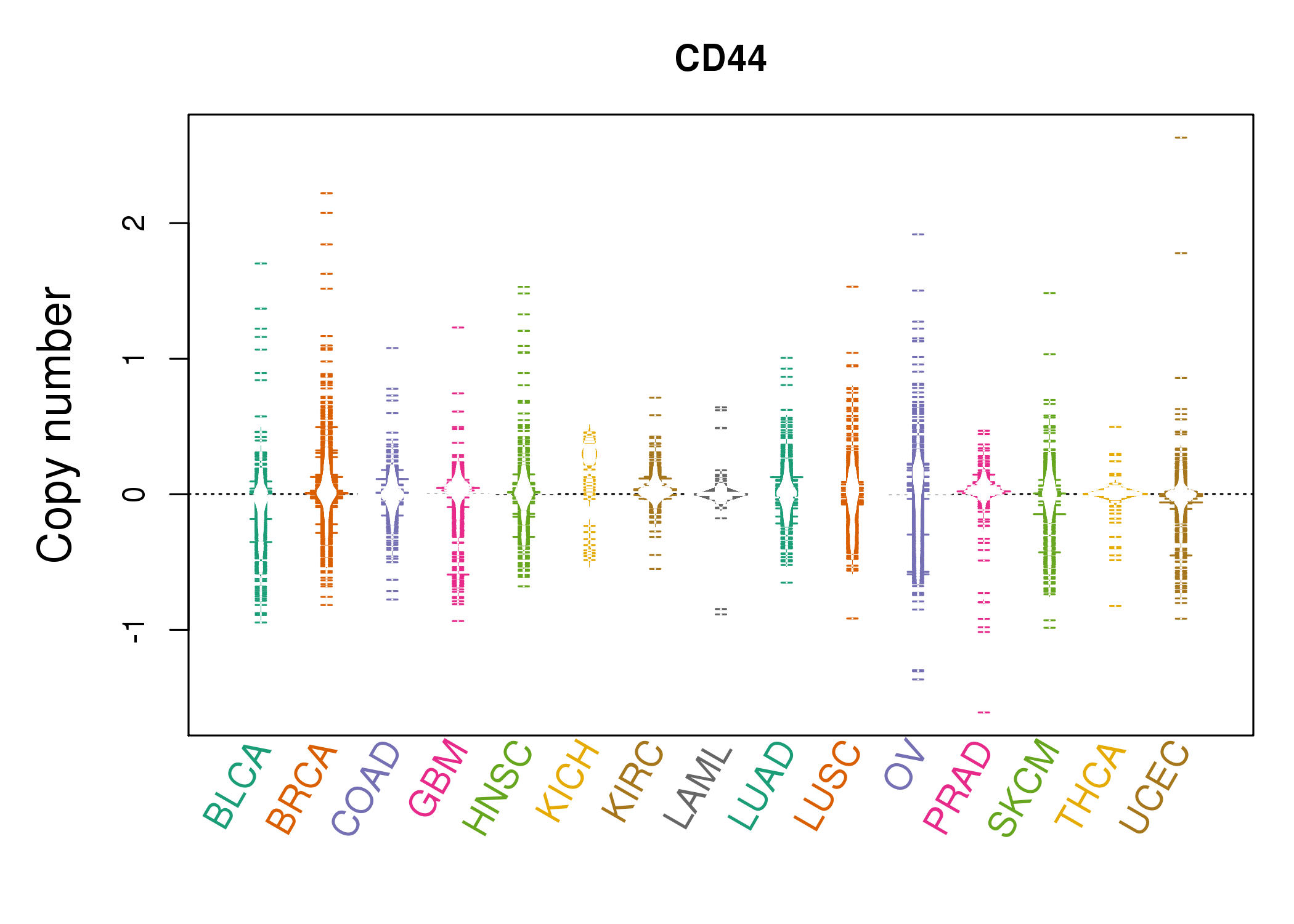 |
| cf) Tissue ID[Tissue type]: BLCA[Bladder Urothelial Carcinoma], BRCA[Breast invasive carcinoma], CESC[Cervical squamous cell carcinoma and endocervical adenocarcinoma], COAD[Colon adenocarcinoma], GBM[Glioblastoma multiforme], Glioma Low Grade, HNSC[Head and Neck squamous cell carcinoma], KICH[Kidney Chromophobe], KIRC[Kidney renal clear cell carcinoma], KIRP[Kidney renal papillary cell carcinoma], LAML[Acute Myeloid Leukemia], LUAD[Lung adenocarcinoma], LUSC[Lung squamous cell carcinoma], OV[Ovarian serous cystadenocarcinoma ], PAAD[Pancreatic adenocarcinoma], PRAD[Prostate adenocarcinoma], SKCM[Skin Cutaneous Melanoma], STAD[Stomach adenocarcinoma], THCA[Thyroid carcinoma], UCEC[Uterine Corpus Endometrial Carcinoma] |
| Top |
| Gene Expression for CD44 |
| * CCLE gene expression data were extracted from CCLE_Expression_Entrez_2012-10-18.res: Gene-centric RMA-normalized mRNA expression data. |
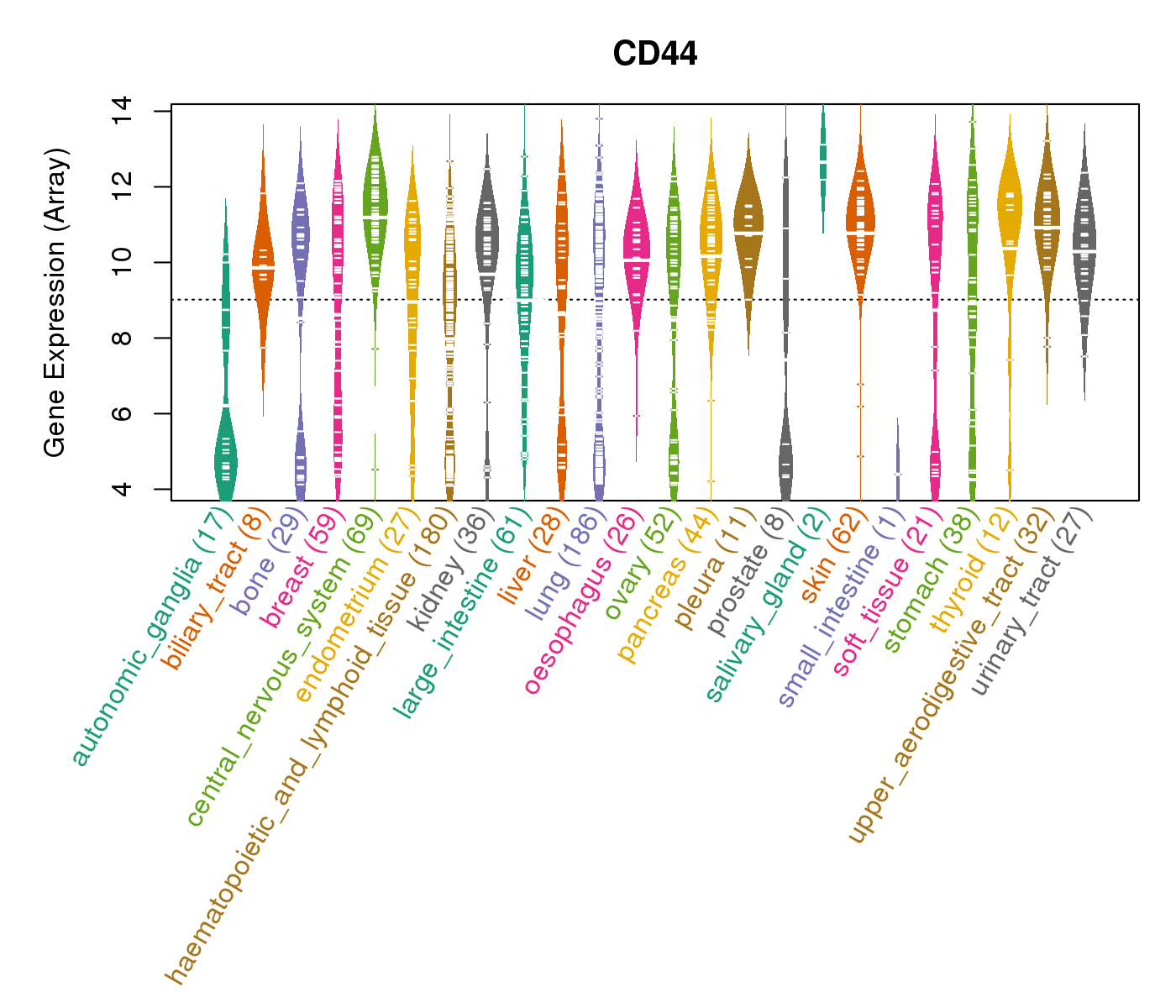 |
| * Normalized gene expression data of RNASeqV2 was extracted from TCGA using R package TCGA-Assembler. The URLs of all public data files on TCGA DCC data server were gathered at Jan-05-2015. Only eight cancer types have enough normal control samples for differential expression analysis. (t test, adjusted p<0.05 (using Benjamini-Hochberg FDR)) |
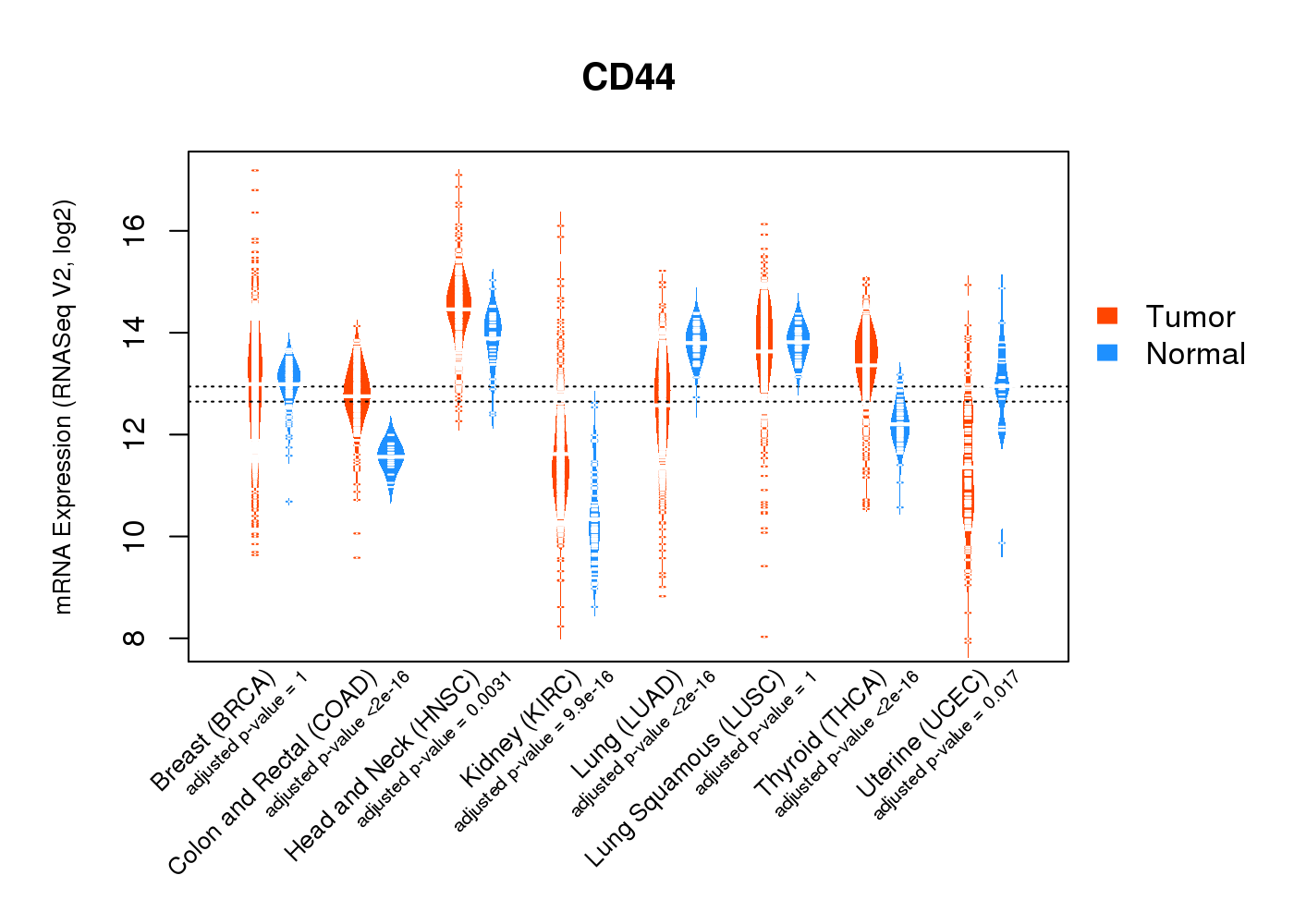 |
| Top |
| * This plots show the correlation between CNV and gene expression. |
: Open all plots for all cancer types
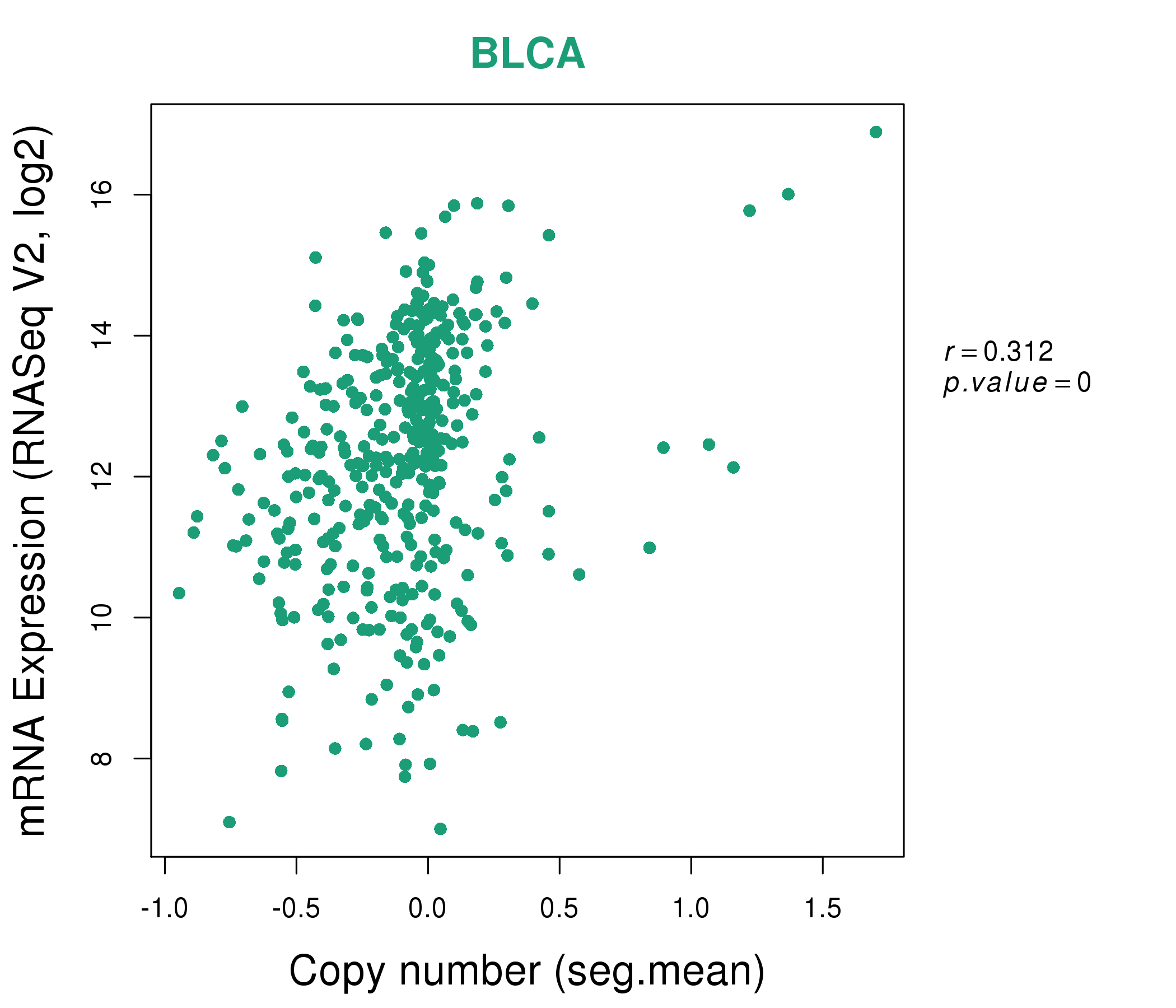 |
|
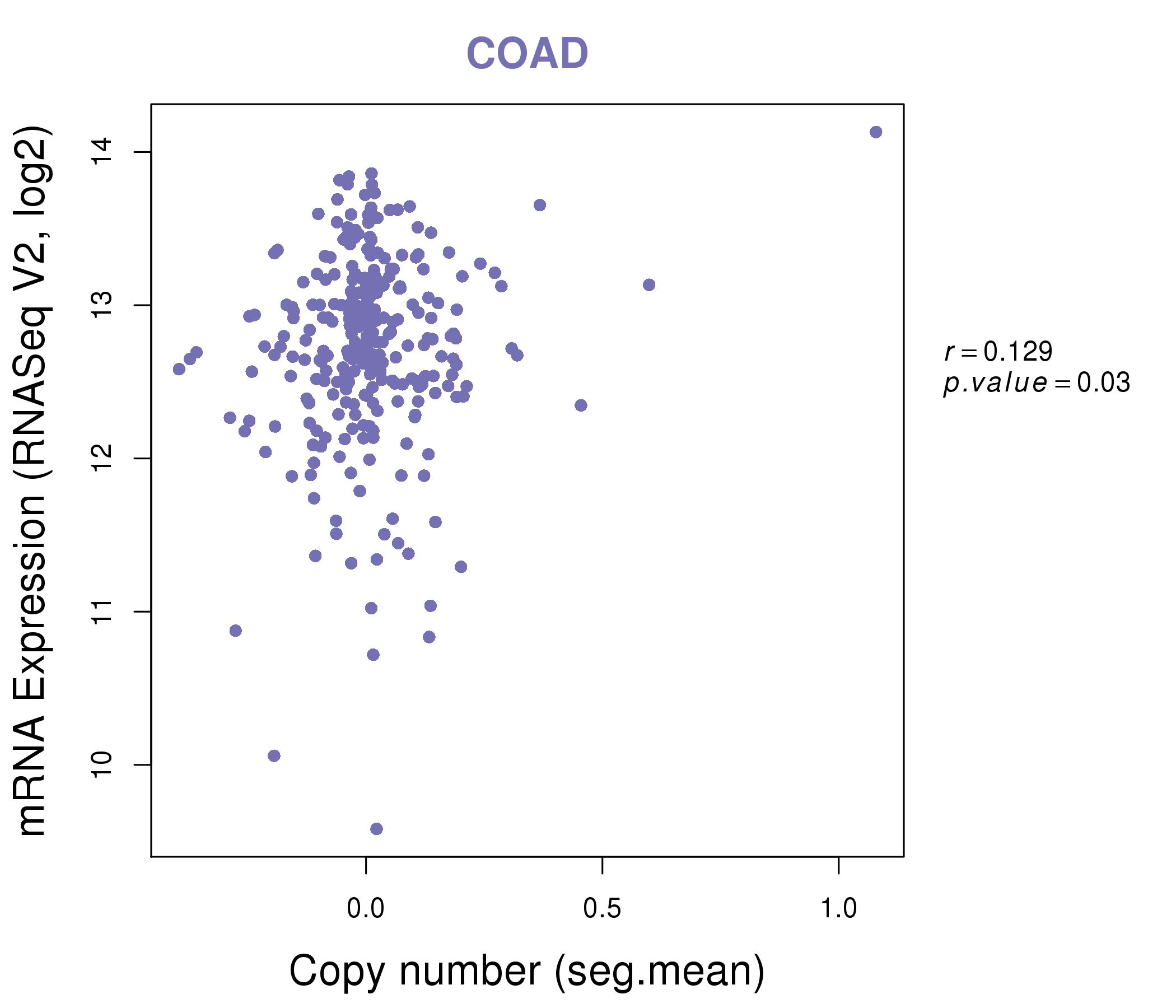 |
|
| Top |
| Gene-Gene Network Information |
| * Co-Expression network figures were drawn using R package igraph. Only the top 20 genes with the highest correlations were shown. Red circle: input gene, orange circle: cell metabolism gene, sky circle: other gene |
: Open all plots for all cancer types
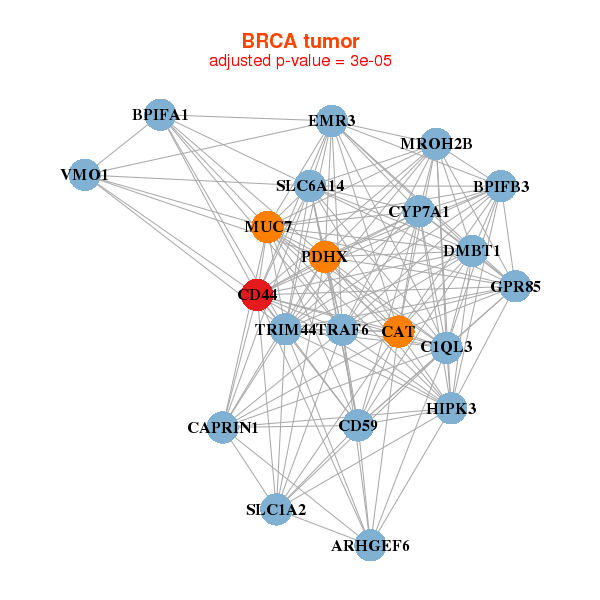 |
|
| ARHGEF6,C1QL3,BPIFB3,CAPRIN1,CAT,CD44,CD59, CYP7A1,DMBT1,EMR3,GPR85,MROH2B,HIPK3,MUC7, PDHX,BPIFA1,SLC1A2,SLC6A14,TRAF6,TRIM44,VMO1 | ANKRD13A,APOBEC3C,ARF6,TMEM248,CD44,CMTM6,DAZAP2, DRAM1,FAM102B,FRMD4B,GLT8D1,LHFPL2,LOC151162,MPZL1, MYOF,PTGFRN,PTPN9,RERG,SLC16A4,SLC37A3,SNX7 |
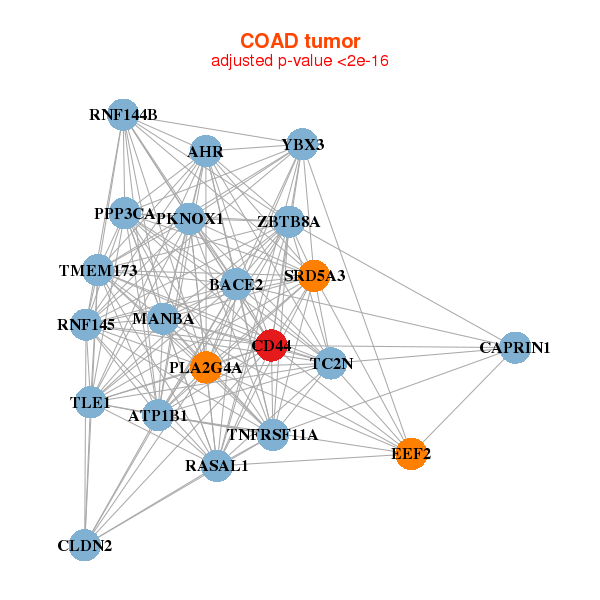 |
|
| AHR,ATP1B1,BACE2,CAPRIN1,CD44,CLDN2,YBX3, EEF2,MANBA,PKNOX1,PLA2G4A,PPP3CA,RASAL1,RNF144B, RNF145,SRD5A3,TC2N,TLE1,TMEM173,TNFRSF11A,ZBTB8A | ACSL4,CD44,DOC2B,HGF,IFI16,IKBIP,LMAN1, LPCAT1,LRP8,MSTO1,NEIL2,PDPN,PTGFR,RAMP3, RIPK2,SELP,SLC43A3,SLFN11,SRM,ST3GAL5,XPOT |
| * Co-Expression network figures were drawn using R package igraph. Only the top 20 genes with the highest correlations were shown. Red circle: input gene, orange circle: cell metabolism gene, sky circle: other gene |
: Open all plots for all cancer types
| Top |
: Open all interacting genes' information including KEGG pathway for all interacting genes from DAVID
| Top |
| Pharmacological Information for CD44 |
| There's no related Drug. |
| Top |
| Cross referenced IDs for CD44 |
| * We obtained these cross-references from Uniprot database. It covers 150 different DBs, 18 categories. http://www.uniprot.org/help/cross_references_section |
: Open all cross reference information
|
Copyright © 2016-Present - The Univsersity of Texas Health Science Center at Houston @ |






